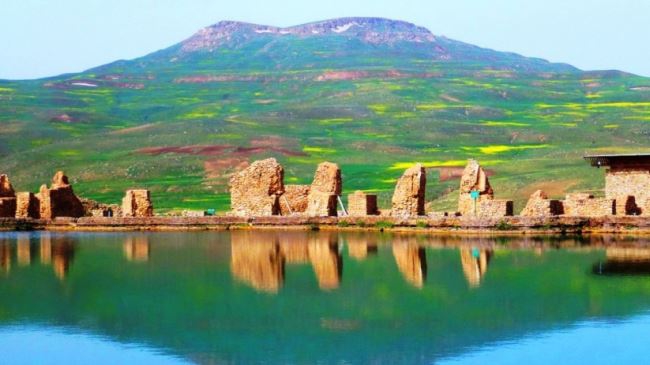 Iran's ancient citadel Throne of Solomon[/caption]
Iran's ancient citadel Throne of Solomon[/caption]Iranian ancient citadel Throne of Solomon (Takht-e Soleyman), known as Zoroastrian fire temple, manifests Persian glorious civilization.
Located in north-western Iran, the site lies in a broad and remote mountain valley between cities of Zanjan and Tekab, consisting of an oval platform about 350 by 550 square meters.
In earlier ancient period the area was known as ĎShizí or ĎAdur Gushnaspí† which literally means the ĎFire of the Warrior Kingsí; but later after the Arab conquest the region was named the Throne of Solomon.
Built during the Sassanid era, the ruins introduce the principal Zoroastrian sanctuary and a Sassanid temple dedicated to Anahita, the goddess of water and fertility in ancient Persian mythology.
Fire and water have been among the fundamental elements for the Iranian peoples since ancient times. Fire was believed to conceive a divine messenger between the visible world and the invisible (gods) and water was considered as the source of life.
There is a lake with floor springs at the region surrounded by massive stone walls and 38 towers.
A volcanic conical core mount is also located near the area which is known as Solomonís Prison (Zendan-e Soleyman).
The 107-meter tall mount has a giant hole on top, with 65meter span and nearly 80 meter depth.
Centuries ago, the hole was full of water, fed by floor springs, but later it was dried due to an earth quake.
The structures partly restored in the Mongol period (Ilkhanid) in 13th century. The designs of the fire temple, the palace and the general layout have strongly influenced the development of Islamic architecture.
Archaeological excavations have unveiled traces of an occupation during the Achaemenid period, as well as later Parthian settlements in the citadel.
Persia was a conquering empire but also regarded in some ways as one of the more glorious and benevolent civilizations of antiquity.
As an outstanding ensemble of royal architecture, Throne of Solomon (Takht-e Soleyman) was inscribed on UNESCOís World Heritage list on July 3, 2003.
By Press TV
The Iran Project is not responsible for the content of quoted articles.











